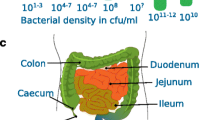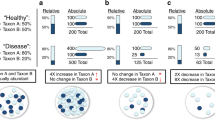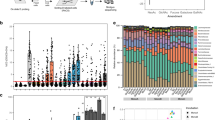Conclusions
Although the results of experiments carried out to date have not given unambiguous answers to the question of which polysaccharides are being utilized byBacterioides in the colon, the results nonetheless encourage us to think that it may be possible to develop methods for answering this and related questions in the furture. Given the complexity of the in vivo environmental and the impossibility of knowing, much less controlling, all parameters, it will probably be necessary to use more than one approach to answering a particular question and assume that if anseers obtained by different approaches are consistent, they are probably correct. For example, the general conclusions from the experiments testing the performance of mutants in the germfree mouse model are in agreement with those arising from direct biochemical analysis of human feces. Also, results from these experiments with help to guide the design of more specific antibody probes because they indicate which polysaccharides are most likely to be important. A bootstrap type of approach in which each successive set of experiments produces information that makes possible a more specific type of probe may be the only approach that makes sense when dealing with metabolically versatile organisms in a highly complex ecosystem.
Similar content being viewed by others
References
Attwood GT, Lockington RA, Xue GP & Brooker JD (1988) Use of a unique gene sequences as a probe to enumerate a strain ofBacteroides Ruminicola introduced into the rumen. Appl. Environ. Microbiol. 54: 534–539
Johnson JL (1978) Taxonomy of theBacteroides. I. Deoxyribonucleic acid homologies amongBacteroides fragilis and other saccarolyticBacteroides species. Int. J. Syst. Bacteriol. 28: 245–256
Kuritza AP & Salyers AA (1985) Use of a species specific DNA hybridization probe for enumeratingBacTeroides vulgatus in human feces. Appl. Environ. Microbiol. 50: 958–964
Kuritza AP, Shaughnessy P & Saleers AA (1986) Enumeration of polysaccharide degradingBacteroides species in human feces using species-specific DNA probes. Appl. Environ. Microbiol. 51: 385–390
McCarthy RE & Salyers AA (1986) Evidence that polygalacturonic acid is not an important substante forBacteroides species in the colon. Appl. Environ. Microbiol. 52: 9–16
McCarthy RE, Pajeau M & Salyers AA (1988) Assessing the possible of starch as a carbohydrate source forBacteroides growing in the human colon. Appl. Environ. Microbiol. 54: 1911–1916
Moore WEC, Cato EP & Holdeman LV (1978) Some current concepts in intestinal bacteriology. Amer. J. Clin. Nutr. 31: S33-S42
Salyers AA (1984)Bacteroides of the human lower intestinal tract. Ann. Rev. Microbiol. 38: 293–313
Salyers AA, Pajeau M & McCarthy RE (1988) Assessing the importance of mucopolysaccharides as substrates forBacteroides thetaiotaomicron growing in the intestinal tracts of ex-germfree mice. Apll. Environ. Microbiol. 54: 1970–1976
Salyers AA, Vercellotti JP, West AH & Wilkins TD (1977) Fermatention of mucin and plant polysaccharides by strains ofBacteroides from the human colon. Appl. Environ. Microbiol. 33: 319–322
Stahl DA, Flesher B, Mansfield HR & Montgomery L (1988) Use of phylogenetically based hybridization probes for studies of ruminal microbial ecology. Appl. Environ. Microbiol. 54: 1079–1084
Author information
Authors and Affiliations
Rights and permissions
About this article
Cite this article
Salyers, A.A. Molecular and biochemical approaches to determining what bacteria are doing in vivo. Antonie van Leeuwenhoek 55, 33–38 (1989). https://doi.org/10.1007/BF02309617
Received:
Accepted:
Issue Date:
DOI: https://doi.org/10.1007/BF02309617




